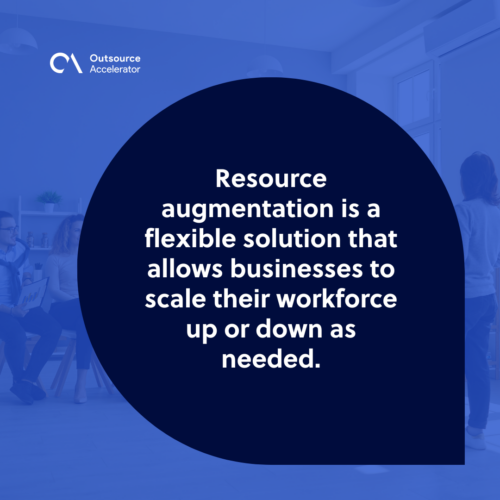Resource augmentation: Unleashing talent expansion’s full potential

Businesses constantly strive to remain competitive and meet the demands of their customers. Strengthening the workforce is one way to stay ahead of the curve.
One of the most effective ways is by leveraging the power of resource augmentation. This process involves adding external talent to an existing workforce to meet specific goals.
In this article, we’ll explore what resource augmentation is, its different types, and its advantages. We’ll also include some tips on how to implement it effectively.
What is resource augmentation?
Resource augmentation is a strategic approach that expands a company’s talent pool by adding external resources. In this case, “resources” means people.
The approach involves hiring professionals on a temporary or project basis. They are needed to fill skill gaps, meet project demands, or achieve specific business objectives.
It is a flexible solution that allows businesses to scale their workforce up or down as needed. It’s often used to complement existing staff rather than replace them.
Resource augmentation is prevalent in the IT industry. The US Bureau of Labor Statistics reported that computer and IT roles will continue to grow at 15% until 2031. It means the sector will create further job opportunities, making more room for augmentation.

5 types of resource augmentation
Resource augmentation comes in many forms, here are the most common types:
1. Staff augmentation
Staff augmentation involves hiring professionals temporarily to fill skill gaps or meet specific project needs. This is ideal for companies that need to scale their workforce quickly or require specific expertise for a short period.
2. Project-based outsourcing
Project-based outsourcing involves partnering with external agencies or individuals to handle specific projects or tasks. This approach offers flexibility in managing project timelines, accessing niche expertise, and controlling costs.
3. Managed services
Managed services entrust the management of specific business functions to a third-party provider. This type of resource augmentation is ideal for companies that want to focus on their core competencies, leaving non-core activities to external experts.
Booth & Partners, a premier managed services provider in the Philippines, is known for its holistic managed services. They take care of the dirty work in building an offshore team which their clients can manage in return.
4. Offshore outsourcing
Offshore outsourcing delegates business processes or functions to service providers in different countries. It offers advantages like cost savings, access to a global talent pool, and round-the-clock productivity.
5. Nearshore outsourcing
Conversely, nearshore outsourcing delegates tasks to service providers in neighboring or nearby countries. This approach offers benefits like cultural and geographical proximity, effective communication, and potential cost savings compared to onshore resources.
Advantages of resource augmentation
Resource augmentation provides several advantages for organizations seeking to enhance their capabilities. Some of the process’s key benefits are:
Increased flexibility
Resource augmentation allows companies to scale their workforce up or down based on project requirements. It warrants greater flexibility in managing workloads and adapting to changing market demands.
Access to specialized skills
By integrating external resources, organizations gain access to a broader range of untapped, specialized skills and expertise. This allows for the efficient execution of complex projects and the ability to tackle diverse challenges.
Cost optimization
Resource augmentation provides a cost-effective solution. Businesses won’t have to hire full-time employees or establish in-house teams for specific tasks or projects.
It optimizes costs by leveraging external resources for short-term or specialized requirements.
Accelerated time-to-market
Companies can speed up their time-to-market by utilizing external specialized knowledge and experience. This enables faster project execution, enhanced productivity, and a competitive edge in the market.
Risk mitigation
Resource augmentation can help mitigate risks associated with talent gaps, limited resources, or expertise constraints.
Utlizing outside talent lets organizations reduce dependency on a single individual or a small team. As a result, it minimizes the impact of potential disruptions.

Resource augmentation framework
Companies can effectively implement resource augmentation through the following steps:
- Identify your needs – First, analyze existing skill gaps, workload distribution, and project demands. Doing so, allows firms to determine the most suitable type of resource augmentation.
- Evaluate and select – Once the needs are identified, evaluate potential external resources or service providers. Consider their expertise, experience, track record, cost-effectiveness, and cultural fit.
- Assimilate new team members – Integrate the selected resources seamlessly into the existing team structure. Provide clear guidelines, communicate expectations, and facilitate knowledge transfer for smooth collaboration and efficient workflow.
- Provide consistent support – Offer the augmented team members continuous support, guidance, and training. Foster a collaborative environment, encourage open communication, and provide professional growth and development opportunities.
Tips to effectively implement resource augmentation
The successful implementation of resource augmentation can be bolstered by these tips:
- Establish clear communication and collaboration channels to ensure external resources align with your company’s goals and values.
- Integrate external hires into your team by providing access to the necessary tools, systems, and processes.
- Track and evaluate the performance of external employees to ensure that they meet your expectations and goals.
- Ensure that external hires align with your company’s culture and values to minimize conflicts and improve collaboration.
- Maintain data security by establishing strict access controls and data protection policies for external workers.
- Manage team dynamics by establishing clear roles and responsibilities.
- Provide regular feedback and address conflicts promptly.
Resource augmentation is a powerful tactic that enables organizations to unlock the potential of talent expansion. By integrating external resources strategically, companies can enhance their capabilities, optimize costs, accelerate growth, and gain a competitive advantage.







 Independent
Independent




